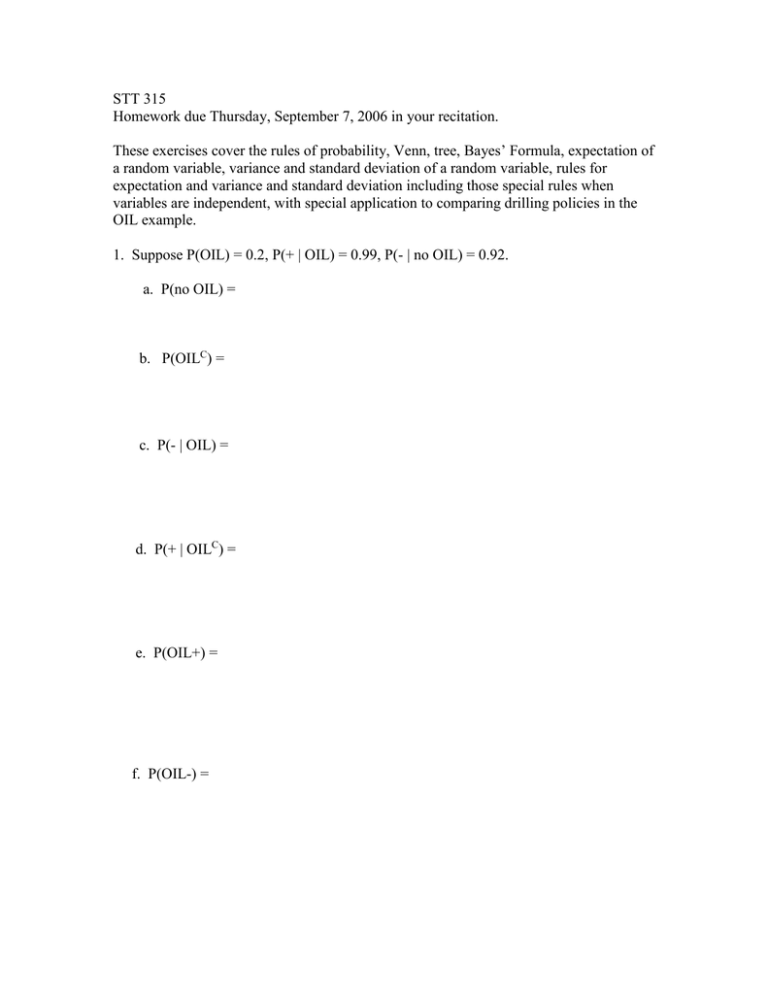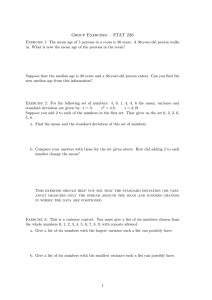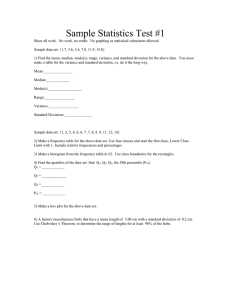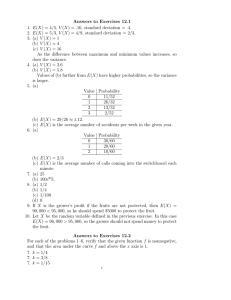STT 315 Homework due Thursday, September 7, 2006 in your recitation.
advertisement

STT 315 Homework due Thursday, September 7, 2006 in your recitation. These exercises cover the rules of probability, Venn, tree, Bayes’ Formula, expectation of a random variable, variance and standard deviation of a random variable, rules for expectation and variance and standard deviation including those special rules when variables are independent, with special application to comparing drilling policies in the OIL example. 1. Suppose P(OIL) = 0.2, P(+ | OIL) = 0.99, P(- | no OIL) = 0.92. a. P(no OIL) = b. P(OILC) = c. P(- | OIL) = d. P(+ | OILC) = e. P(OIL+) = f. P(OIL-) = g. P(OILC+) = h. P(OILC-) = i. Present the complete Venn from the above. j. Present the complete tree from the above. k. P(OIL | +) = (Bayes’) l. P(OIL | -) (Bayes’) m. P(OILC | +) from (k) = 2. Refer to (1j). Suppose the cost to test is 20, the cost to drill is 45, and the gross return from oil is 500 (but you have to drill and oil has to be there otherwise the gross return is 0). a. Calculate E X where random variable X denotes the net return from the policy “do not test, just drill.” b. Calculate E Y where random variable Y denotes the net return from the policy “pay to test but only drill if the test turns out +.” Which policy has the largest expected net return? 3. The distribution of a random variable W (list of values w and their probabilities p(w)) is given below. w p(w) w p(w) w2 p(w) (w – EW)2 p(w) ___________________________________________________________________ 2 0.4 2(.4) = 0.8 22 (.4) = 1.6 (2 ) 0.4 = 4 0.1 6. 0.5 ___________________________________________________________________ totals 1.0 EW= E W2 = Variance W = a. Calculate E W. Plot the distribution (i.e. plot of value w on the horizontal axis and its probability p(w) on the vertical axis. E W is necessarily the “balance point” of the distribution. Does this appear to be true just from looking at it? b. Calculate E (W2) (we usually just write E W2 ). This is the “expected square of W.” c. Calculate Variance W = E (W2) – (E W )2. This is the “expected square minus the square of the expectation.” Variance of W has a role to play in how volatile repeated samples of W will be. d. Standard deviation of W is defined to be the square root of variance of W. What is the standard deviation of random variable W? e. Calculate Variance W from the final column above. 3. Rules of E. Random variables X, Y have E X = 2.3, E Y = 5.4. a. E(X + Y) = b. E(Y – X) = c. E(2 X + Y – 4) = 4. Rules of Variance. Refer to (3). Suppose Variance X = 2, Variance Y = 3. a. We cannot in general say what E (XY) is. If, however, X is independent of Y we can determine E (XY). What is its value if X is independent of Y? b. What does it mean for random variables to be independent? c. If X, Y are independent what then is Variance(X + Y)? d. Refer to (c). What is standard deviation of X+Y? e. Refer to (c). What is standard deviation of (7X+6)? f. Refer to (c). What is standard deviation of (5 X – 4Y + 3)?







